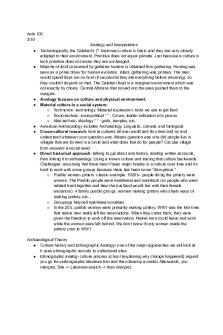Archaeology: Analogy and Interpretation PDF

| Title | Archaeology: Analogy and Interpretation |
|---|---|
| Course | Introduction To Archaeology |
| Institution | Virginia Commonwealth University |
| Pages | 2 |
| File Size | 66.5 KB |
| File Type | |
| Total Downloads | 33 |
| Total Views | 165 |
Summary
Anthropology/Intro to Archaeology notes on analogy and interpretation. ...
Description
Anth 105 3/19 ●
●
● ●
● ●
●
Analogy and Interpretation Technologically, the Calahari’s (? bushmen) culture is basic and they are very closely adapted to their environment. Primitive does not equal primate. Just because a culture is tech primitive does not mean they are unchanged. Majority of food consumed by gatherer hunters is obtained thru gathering. Hunting was seen as a prime driver for human evolution, infact, gathering was primary. The men would spend days out on hunt (if successful they ate everything before returning), so they couldn’t depend on that. The Calahari lived in a marginal environment which was not exactly by choice. Central Africans that moved into the area pushed them to the margins. Analogy focuses on culture and physical environment. Material culture in a social system: ○ Technomic- technology. Material expression: tools we use to get food ○ Socio-technic- sociopolitical “ “ : Crown, leader indication of a person ○ Ideo-technic- ideology “ “ : gods, temples, etc. American Anthropology includes Archaeology, Linguistic, cultural, and biological. Cross-cultural research: look at cultures all over world and thru time and try and understand whatever your question was. Means question was why did people live in villages that are formed in a circle and what does that do for people? Circular village form answers a social need. Direct historical approach: talking to ppl about oral history, reading written accounts, then linking it to archaeology. Using a known culture and tracing that culture backwards. Challenges: assuming that there hasn’t been major breaks in a culture over time and it’s hard to work with some groups because there has been some “disruptions.” ○ Pueblo woman potters: classic example. 1920’s- people doing the pottery were women. The Pueblo people were matrilineal and matrilocal (so people who were related lived together and then the husband would live with their female ancestors). 4 family pueblo groups: women making pottery who share ways of making pottery, etc… ○ Groupings help tell matrilineal societies. ○ In the 20’s, pueblo women were primarily making pottery. WW1 was the first time that native men really left the reservations. When they came back, they were given the freedom to work off the reservation. Native men could leave and work while the women were left behind. We don’t know if only women made the pottery prior to WW1.
Archaeological Theory ● Culture history and Ethnographic Analogy- one of the major approaches we will look at. It uses ethnographic records to understand sites. ● Ethnographic analog- culture process school (explaining why change happened) argued you go thru ethnographic literature first and then develop a model. Afterwards, you interpret. Site -> Literature search -> then interpret.
○
●
●
●
●
●
Ethnoarchaeology: We can’t just rely on the literature because culture anthropologists are not trained as archaeologists. Beliefs, religion, political systems, dance, music, etcetera. This is archaeology of living people. Observing how they hunt and throw things away. Foragers v. Collectors ○ Nunamiut model- 2 broad types of gatherer hunters, foragers and collectors. ○ Foragers: small groups move around landscape in a seasonal round from different food locations throughout the year. Only see small sites. ○ Collectors: in stable environments where larger family groupings, for several months out of the year, send groups to get resources then return them back to the civilization. More people = more societal rules. Larger settlements get built, taxing the environment can become frequent. Thus, technology becomes more efficient. Evidence for larger concentrations of people. ○ 2 choices to stop taxing environment: groups of people die, or developing new technology. More on the Calahari: ethnoarchaeologists wondering how they organize themselves. Common area shared by everyone (communal area) that have nuclear areas (familial areas). Beyond that is the “special activity” area, then the garbage edge. Behavioral Archaeology: focuses on the relationships between people and artifacts. ○ Context: systemic (what remnants represented) and archaeological (what remnants we see now) ○ Formation processes: cultural or c-transforms. Natural or n-transforms. ○ Looking at artifacts as if they are living things (procured, made, used, discarded-Life History). If we understand all thoughts/decisions to manufacture and obtain material and how it is used, it allows us to understand the kinds of decisions people made. Scales of Human Behavioral Variation- interaction scale (3). Starting with 1 artifact then building up to society. ○ Artifact of a person- 1 person working with 1 artifact. Look at this relationship, it is the lowest scale in his hierarchy. ○ Activity scale- multiple people and artifacts all interacting with on another to do a particular activity (like cooking or butchering). ○ Systemic scale- all interaction happening at a site....
Similar Free PDFs

Archaeology
- 2 Pages

Herbert Spencer- Organic Analogy
- 5 Pages

Bode Plots and Interpretation
- 2 Pages

Archaeology Dating Methods Essay
- 4 Pages

Archaeology in history
- 23 Pages

Cell City Analogy Assignment
- 2 Pages

Cell Analogy Project Computers
- 17 Pages
Popular Institutions
- Tinajero National High School - Annex
- Politeknik Caltex Riau
- Yokohama City University
- SGT University
- University of Al-Qadisiyah
- Divine Word College of Vigan
- Techniek College Rotterdam
- Universidade de Santiago
- Universiti Teknologi MARA Cawangan Johor Kampus Pasir Gudang
- Poltekkes Kemenkes Yogyakarta
- Baguio City National High School
- Colegio san marcos
- preparatoria uno
- Centro de Bachillerato Tecnológico Industrial y de Servicios No. 107
- Dalian Maritime University
- Quang Trung Secondary School
- Colegio Tecnológico en Informática
- Corporación Regional de Educación Superior
- Grupo CEDVA
- Dar Al Uloom University
- Centro de Estudios Preuniversitarios de la Universidad Nacional de Ingeniería
- 上智大学
- Aakash International School, Nuna Majara
- San Felipe Neri Catholic School
- Kang Chiao International School - New Taipei City
- Misamis Occidental National High School
- Institución Educativa Escuela Normal Juan Ladrilleros
- Kolehiyo ng Pantukan
- Batanes State College
- Instituto Continental
- Sekolah Menengah Kejuruan Kesehatan Kaltara (Tarakan)
- Colegio de La Inmaculada Concepcion - Cebu








